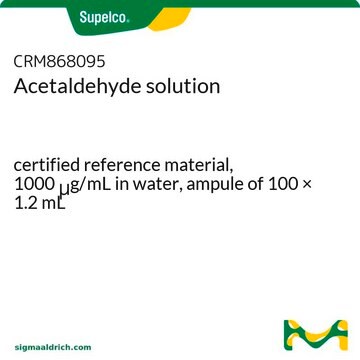00070
Acetaldeide
puriss. p.a., anhydrous, ≥99.5% (GC)
Sinonimo/i:
Etanale
About This Item
Prodotti consigliati
Origine biologica
synthetic
Livello qualitativo
Grado
anhydrous
puriss. p.a.
Densità del vapore
1.52 (vs air)
Tensione di vapore
14.63 psi ( 20 °C)
Saggio
≥99.5% (GC)
Forma fisica
liquid
Temp. autoaccensione
365 °F
Qualità
anhydrous
Limite di esplosione
60 %
Impurezze
≤0.5% free acid (as CH3COOH)
Residuo dopo evaporazione
≤0.002%
Indice di rifrazione
n20/D 1.332 (lit.)
n20/D 1.332
P. eboll.
21 °C (lit.)
Punto di fusione
−125 °C (lit.)
Densità
0.785 g/mL at 25 °C (lit.)
Cationi in tracce
Al: ≤0.5 mg/kg
Ba: ≤0.1 mg/kg
Bi: ≤0.1 mg/kg
Ca: ≤0.5 mg/kg
Cd: ≤0.05 mg/kg
Co: ≤0.02 mg/kg
Cr: ≤0.02 mg/kg
Cu: ≤0.02 mg/kg
Fe: ≤0.5 mg/kg
K: ≤0.5 mg/kg
Li: ≤0.1 mg/kg
Mg: ≤0.1 mg/kg
Mn: ≤0.02 mg/kg
Mo: ≤0.1 mg/kg
Na: ≤0.5 mg/kg
Ni: ≤0.02 mg/kg
Pb: ≤0.1 mg/kg
Sr: ≤0.1 mg/kg
Zn: ≤0.1 mg/kg
Temperatura di conservazione
2-8°C
Stringa SMILE
CC=O
InChI
1S/C2H4O/c1-2-3/h2H,1H3
IKHGUXGNUITLKF-UHFFFAOYSA-N
Cerchi prodotti simili? Visita Guida al confronto tra prodotti
Categorie correlate
Descrizione generale
Applicazioni
Avvertenza
Avvertenze
Danger
Indicazioni di pericolo
Consigli di prudenza
Classi di pericolo
Carc. 1B - Eye Irrit. 2 - Flam. Liq. 1 - Muta. 2 - STOT SE 3
Organi bersaglio
Respiratory system
Codice della classe di stoccaggio
3 - Flammable liquids
Classe di pericolosità dell'acqua (WGK)
WGK 3
Punto d’infiammabilità (°F)
-38.0 °F - closed cup
Punto d’infiammabilità (°C)
-38.89 °C - closed cup
Dispositivi di protezione individuale
Eyeshields, Faceshields, Gloves
Choose from one of the most recent versions:
Possiedi già questo prodotto?
I documenti relativi ai prodotti acquistati recentemente sono disponibili nell’Archivio dei documenti.
I clienti hanno visto anche
Protocolli
-Tolualdehyde; Valeraldehyde; Isovaleraldehyde
Il team dei nostri ricercatori vanta grande esperienza in tutte le aree della ricerca quali Life Science, scienza dei materiali, sintesi chimica, cromatografia, discipline analitiche, ecc..
Contatta l'Assistenza Tecnica.






